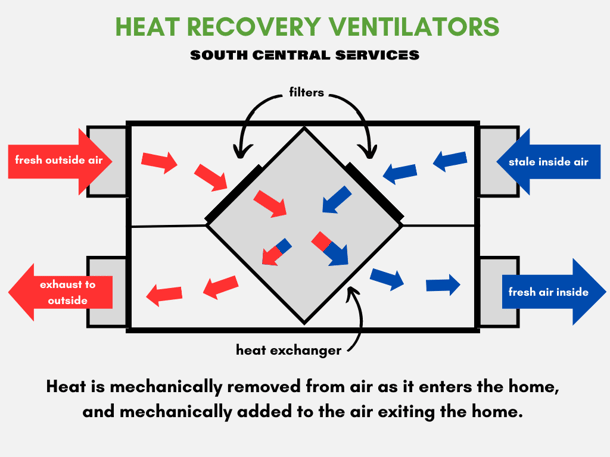Discovering the Advantages of Heat Recovery Ventilation for Power Effectiveness in Residences
Heat Recovery Ventilation (HRV) systems provide house owners a functional method to boosting power performance. By reclaiming warmth from outgoing air, these systems can considerably lower cooling and heating costs. Additionally, they provide a constant supply of fresh air, boosting interior air top quality and comfort levels. As property owners think about lasting choices, understanding the subtleties of HRV systems ends up being progressively vital. What elements should one assess prior to making such an investment?
Recognizing Heat Recovery Ventilation Systems

How HRV Enhances Indoor Air Quality

Energy Cost Savings: The Monetary Advantages of HRV
Taking full advantage of energy effectiveness, heat recovery ventilation (HRV) systems use substantial monetary advantages for house owners. By recuperating and recycling heat from exhaust air, HRVs considerably minimize heating & cooling expenses. This innovation can result in energy financial savings of as much as 30%, relying on environment and usage patterns. Homeowners usually discover decreased energy expenses quickly after installment, making HRVs a monetarily sensible investment in time. Additionally, numerous areas offer motivations or refunds for energy-efficient upgrades, better boosting the monetary appeal. As power costs continue to increase, the cost-effectiveness of HRVs becomes significantly clear. Overall, the incorporation of HRV systems not only promotes power performance yet likewise adds to lasting monetary savings for households.
The Ecological Effect of Heat Recovery Ventilation
A considerable environmental advantage of heat recovery ventilation (HRV) systems depends on their capability to lower total power intake. By reclaiming warmth from exhaust air and moving it to incoming fresh air, HRV systems reduce the need for energy-intensive home heating and cooling down methods. This decrease in power need adds to reduce greenhouse gas emissions, as less nonrenewable fuel source is required to maintain comfortable interior temperature levels. Additionally, HRV visit this page systems improve interior air Check This Out high quality by effectively trading stale air with fresh outside air, decreasing dependence on mechanical air conditioning systems that can damage the atmosphere. On the whole, the implementation of HRV systems supports sustainable living methods and aligns with international initiatives to battle climate change by promoting energy effectiveness in domestic setups.
Selecting the Right HRV System for Your Home
Just how can house owners assure they pick the appropriate heat recovery ventilation (HRV) system for their requirements? They must evaluate their home's size and design, as these aspects affect air movement needs. Next, reviewing the system's effectiveness rankings is crucial, as greater scores suggest better performance and energy savings. House owners need to additionally consider setup and upkeep costs, contrasting different brand names and designs for value. Furthermore, it is necessary to review noise degrees, as some systems operate more quietly than others. Consulting with heating and cooling experts can offer tailored referrals based upon specific home problems. Checking out individual testimonials and guarantees can aid in making a notified decision, guaranteeing that the selected HRV system properly enhances interior air quality and energy performance.
Regularly Asked Concerns

Exactly how Frequently Should I Clean or Keep My HRV System?
The regularity of cleaning or preserving a warm healing ventilation (HRV) system normally relies on usage and environmental aspects. Usually, it is recommended to do upkeep every six months to ensure peak efficiency and air top quality.

Can HRV Systems Assist Minimize Moisture Degrees Indoors?
HRV systems can efficiently minimize indoor humidity levels by trading stagnant, humid air with fresh, drier air from outdoors. HRV Heat Recovery Ventilation. This process assists maintain a well balanced indoor setting, boosting convenience and preventing moisture-related issues
What Is the Life-span of a Regular HRV System?
The lifespan of a normal heat recovery ventilation (HRV) system differs, usually lasting between 10 to 15 years. Normal maintenance can prolong its performance and functional life, making sure peak efficiency throughout its usage duration.
Exist Any Kind Of Noise Worry About HRV Equipments?
Sound worry about HRV systems can develop, particularly from fan operation. Lots of modern-day units are created to decrease audio levels, guaranteeing they operate quietly while keeping effectiveness, which addresses potential disturbances in living settings.
Can I Set Up an HRV System Myself, or Do I Need an Expert?
The specific contemplated whether to install the heat recovery ventilation (HRV) system personally or employ a professional. Normally, while do it yourself installment is possible, competence guarantees correct performance and conformity with regional building regulations, enhancing system effectiveness.